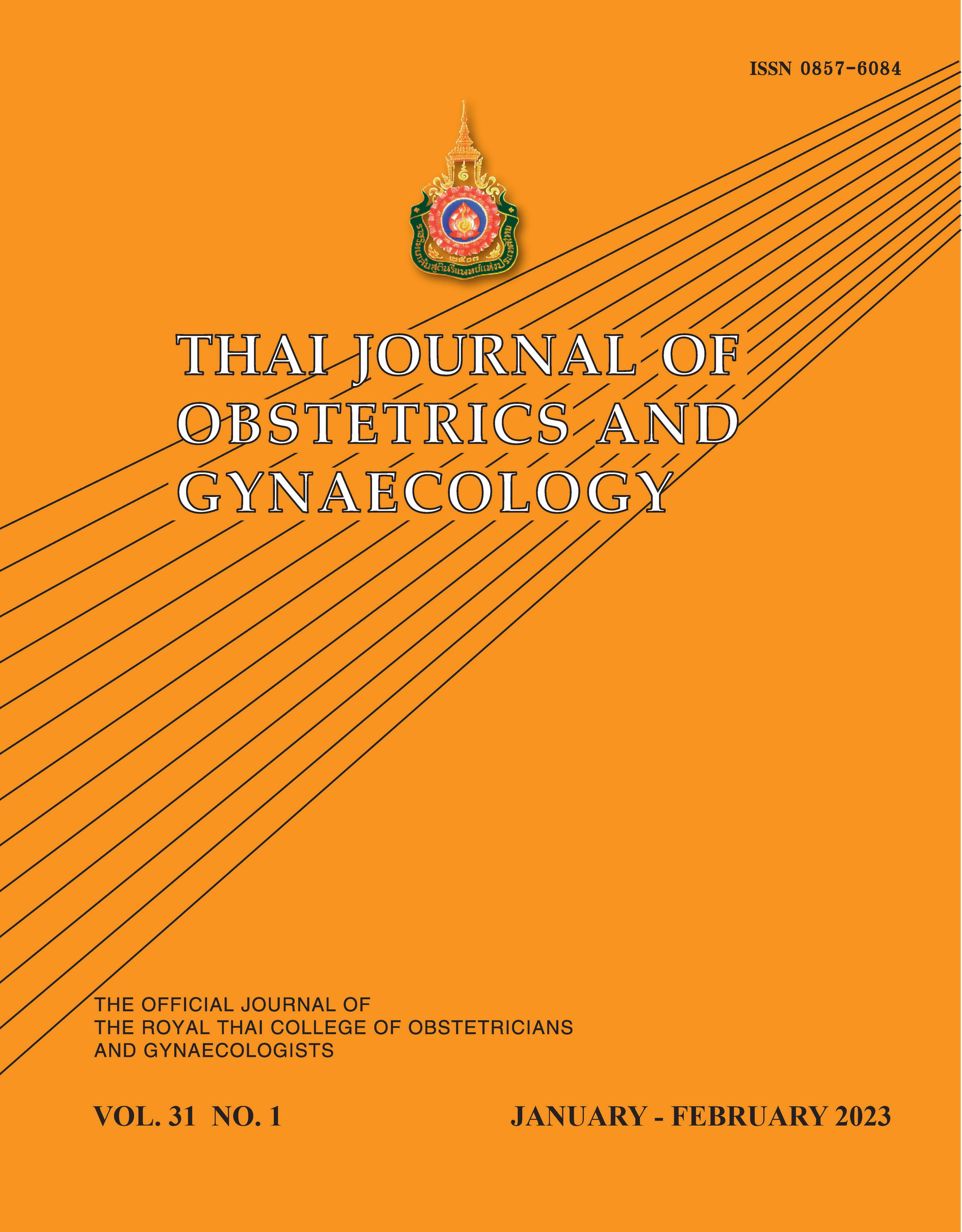Prevalence of Abnormal Glucose Metabolism in Thai Women with Polycystic Ovary Syndrome
Main Article Content
Abstract
Objectives: To assess the prevalence and associated factors of abnormal glucose metabolism (AGM) including impaired fasting glucose (IFG), impaired glucose tolerance (IGT) and diabetes mellitus (DM) in Thai women with polycystic ovary syndrome (PCOS).
Materials and Methods: A retrospective study was conducted in PCOS women who came to the Srinagarind Hospital, Khon Kaen University during 2014 - 2020. Glucose metabolism was determined by a 75-g oral glucose tolerance test. IFG, IGT, and DM were defined according to the American Diabetes Association 2021 criteria. Logistic regression analysis was applied to assess factors associated with AGM. The 95% confidence interval (CI) was calculated to determine the precision of results.
Results: Of 188 patients, AGM was noted in 65 PCOS women, accounting for the prevalence of 34.6 % (95%CI 28.1 - 41.7). Among those with AGM, 10.1%, 23.9%, and 4.8% were diagnosed with IFG, IGT and DM, respectively. Compared to those without AGM, PCOS women with AGM trended to have higher body mass index, waist circumference, waist to hip ratio, blood pressure, and triglyceride level. These clinical parameters and anthropometric measures however were not independently associated with AGM by mean of multiple logistic regression analysis.
Conclusion: Abnormal glucose metabolism was prevalent among PCOS women residing in the Northeast Thailand. Approximately 5% of PCOS women in this study were diagnosed with type 2 DM. Anthropometric measures were not independently associated with AGM.
Article Details

This work is licensed under a Creative Commons Attribution-NonCommercial-NoDerivatives 4.0 International License.
References
Chang RJ, Dumesic DA. Polycystic ovary syndrome and hyperandrogenic states. Yen & Jaffe’s Reproductive Endocrinology. 8th ed. Philadelphia: Elsevier 2018;520-55.
McCartney CR, Marshall JC. Clinical practice. Polycystic ovary syndrome. N Engl J Med 2016;375:54-64.
American College of Obstetricians and Gynecologists’ Committee on Practice Bulletins-Gynecology. ACOG Practice Bulletin No. 194: Polycystic ovary syndrome. Obstet Gynecol 2018;131:e157-e71.
Carmina E. Diagnosis of polycystic ovary syndrome: from NIH Criteria to ESHRE-ASRM guidelines. Minerva Ginecol 2004;56:1-6.
Dumesic DA, Oberfield SE, Stener-Victorin E, Marshall JC, Laven JS, Legro RS. Scientific statement on the diagnostic criteria, epidemiology, pathophysiology, and molecular genetics of polycystic ovary syndrome. Endocr Rev 2015;36:487-525.
Dunaif A. Insulin resistance and the polycystic ovary syndrome: mechanism and implications for pathogenesis. Endocr Rev 1997;18:774–800.
American Diabetes Association. 2. Classification and diagnosis of diabetes: standards of medical care in diabetes-2021. Diabetes Care 2021;44(Suppl 1):S15-S33.
Legro RS, Arslanian SA, Ehrmann DA, Hoeger KM, Murad MH, Pasquali R, et al. Endocrine society. diagnosis and treatment of polycystic ovary syndrome: an endocrine society clinical practice guideline. J Clin Endocrinol Metab 2013;98:4565-92.
Teede HJ, Misso ML, Costello MF, Dokras A, Laven J, Moran L, et al; International PCOS Network. Recommendations from the international evidence-based guideline for the assessment and management of polycystic ovary syndrome. Hum Reprod 2018;33:1602-18.
Ehrmann DA, Barnes RB, Rosenfield RL, Cavaghan MK, Imperial J. Prevalence of impaired glucose tolerance and diabetes in women with polycystic ovary syndrome. Diabetes Care 1999; 22:141-6.
Legro RS, Kunselman AR, Dodson WC, Dunaif A. Prevalence and predictors of risk for type 2 diabetes mellitus and impaired glucose tolerance in polycystic ovary syndrome: a prospective, controlled study in 254 affected women. J Clin Endocrinol Metab 1999;84: 165-9.
Chen X, Yang D, Li L, Feng S, Wang L. Abnormal glucose tolerance in Chinese women with polycystic ovary syndrome. Hum Reprod 2006;21:2027-32.
Lee H, Oh JY, Sung YA, Chung H, Cho WY. The prevalence and risk factors for glucose intolerance in young korean women with polycystic ovary syndrome. Endocrine 2009;36:326-32.
Wongwananuruk T, Rattanachaiyanont M, Indhavivadhana S, Leerasiri P, Techatraisak K, Tanmahasamut P, et al. Prevalence and clinical predictors of insulin resistance in reproductive-aged Thai women with polycystic ovary syndrome. Int J Endocrinol 2012;2012:529184.
Weerakiet S, Tingthanatikul Y, Boonnag P, Wansumrith S, Rattanasiri S, Leelaphiwat S. Can adiponectin predict abnormal glucose tolerance in Thai women with polycystic ovary syndrome? J Obstet Gynaecol Res 2008;34:55-61.
Charnvises K, Weerakiet S, Tingthanatikul Y, Wansumrith S, Chanprasertyothin S, Rojanasakul A. Acanthosis nigricans: clinical predictor of abnormal glucose tolerance in Asian women with polycystic ovary syndrome. Gynecol Endocrinol 2005;21: 161-4.
Pantasri T, Vutyavanich T, Sreshthaputra O, Srisupundit K, Piromlertamorn W. Metabolic syndrome and insulin resistance in Thai women with polycystic ovary syndrome. J Med Assoc Thai 2010;93:406-12.
Revised 2003 consensus on diagnostic criteria and long-term health risks related to polycystic ovary syndrome (PCOS). Human reproduction (Oxford, England) 2004;19:41-7.
Aekplakorn W, Chariyalertsak S, Kessomboon P, Assanangkornchai S, Taneepanichskul S, Putwatana P. Prevalence of diabetes and relationship with socioeconomic status in the Thai population: national health examination survey, 2004-2014. J Diabetes Res 2018;2018:1654530.
Leelaphiwat S, Munkrut N, Weerakiet S, Tingthanatikul Y. Incidence of diabetes mellitus in Thai women with polycystic ovary syndrome. J Med Assoc Thai 2019;102:853-60.
Aekplakorn W, Satheannoppakao W, Putwatana P, Taneepanichskul S, Kessomboon P, Chongsuvivatwong V, et al. Dietary patterns and metabolic syndrome in thai adults. J Nutr Metab 2015;2015:468759.
McNaughton SA, Mishra GD, Brunner EJ. Dietary patterns, insulin resistance, and incidence of type 2 diabetes in the Whitehall II Study. Diabetes Care 2008;31:1343-8.
Buscemi S, Nicolucci A, Mattina A, Rosafio G, Massenti FM, Lucisano G, et al. Association of dietary patterns with insulin resistance and clinically silent carotid atherosclerosis in apparently healthy people. Eur J Clin Nutr 2013;67:1284-90.
Mazidi M, Kengne AP, Mikhailidis DP, Toth PP, Ray KK, Banach M. Dietary food patterns and glucose/insulin homeostasis: a cross-sectional study involving 24,182 adult Americans. Lipids Health Dis 2017;16:192.
Cassar S, Misso ML, Hopkins WG, Shaw CS, Teede HJ, Stepto NK. Insulin resistance in polycystic ovary syndrome: a systematic review and meta-analysis of euglycaemic-hyperinsulinaemic clamp studies. Hum Reprod 2016;31:2619-31.
Cooney LG, Dokras A. Cardiometabolic risk in polycystic ovary syndrome: current guidelines. Endocrinol Metab Clin North Am 2021;50:83-95.


